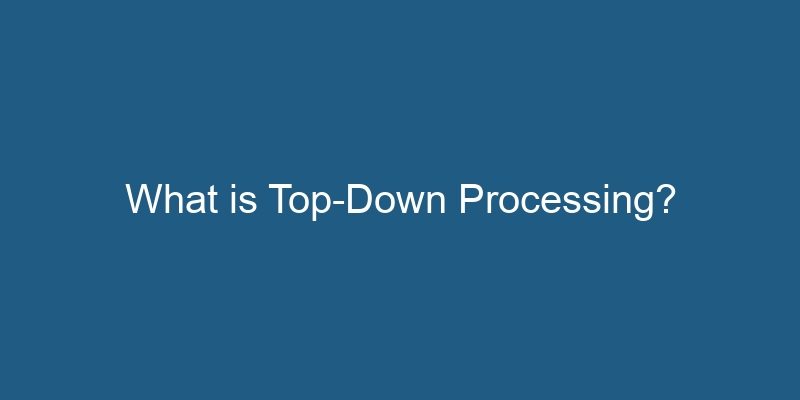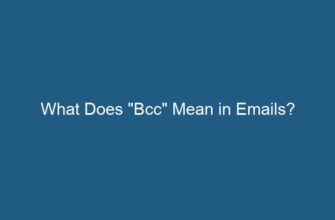In cognitive psychology, top-down processing refers to the way our brains interpret and make sense of incoming information based on our existing knowledge, expectations, and context. It involves using our prior experiences and higher-level cognitive processes to guide our perception and understanding of the world around us. This article aims to delve into the concept of top-down processing, exploring its definition, underlying mechanisms, and its significance in various domains.
- 1. Definition
- 1.1 Components of Top-Down Processing
- 2. Mechanisms of Top-Down Processing
- 2.1 Feature Integration
- 2.2 Pattern Recognition
- 2.3 Semantic Processing
- 2.4 Memory Retrieval
- 3. Significance of Top-Down Processing
- 3.1 Perception and Sensory Processing
- 3.2 Language Comprehension
- 3.3 Problem Solving and Decision Making
- 3.4 Cognitive Biases and Perceptual Illusions
- 4. Frequently Asked Questions (FAQs)
- FAQ 1: What is the difference between top-down and bottom-up processing?
- FAQ 2: Can top-down processing influence our perception of visual illusions?
- FAQ 3: How does top-down processing relate to attention?
- FAQ 4: Can top-down processing lead to errors in perception or cognition?
- FAQ 5: How does top-down processing influence memory retrieval?
- FAQ 6: Is top-down processing only applicable to humans?
- FAQ 7: Can top-down processing be altered or modified?
- FAQ 8: Are there any limitations to top-down processing?
- FAQ 9: How does top-down processing contribute to creativity?
- FAQ 10: Can top-down processing be consciously controlled?
- 5. Conclusion
1. Definition
Top-down processing, also known as conceptually-driven processing, is a cognitive mechanism that involves the use of pre-existing knowledge, expectations, and context to interpret and understand incoming sensory information. It allows us to make sense of the world by using our prior experiences and higher-level cognitive functions, such as memory, attention, and reasoning.
1.1 Components of Top-Down Processing
Top-down processing encompasses several key components:
- Schemas and Mental Models: Our brains store generalized knowledge structures, known as schemas, and mental models, which represent our understanding of specific situations or concepts. These pre-existing mental frameworks play a crucial role in guiding our perception and interpretation of new information.
- Expectations: Based on our past experiences and knowledge, we develop expectations about how certain events, objects, or situations should unfold or appear. These expectations influence the way we perceive and interpret incoming information.
- Context: The surrounding context provides additional cues and information that help us make sense of ambiguous or incomplete stimuli. Our brains use contextual information to fill in the gaps and form a coherent understanding of the sensory input.
- Attention: Top-down processing also involves the allocation of attention selectively to relevant stimuli based on our goals, expectations, and prior knowledge. It allows us to filter out irrelevant information and focus on what is most important.
2. Mechanisms of Top-Down Processing
Top-down processing operates through several interconnected mechanisms:
2.1 Feature Integration
Feature integration refers to the process of combining individual sensory features, such as color, shape, and motion, into a cohesive perceptual experience. Top-down processing facilitates feature integration by providing expectations and mental templates that guide the integration process.
2.2 Pattern Recognition
Top-down processing aids in pattern recognition by allowing us to quickly identify familiar patterns, objects, or scenes based on our stored knowledge and expectations. It enables us to make sense of complex stimuli by recognizing the underlying structure or meaning.
2.3 Semantic Processing
Top-down processing is closely associated with semantic processing, which involves extracting meaning from sensory input. By drawing on our semantic knowledge and context, we can understand the intended message or significance of the information.
2.4 Memory Retrieval
Our existing memories play a crucial role in top-down processing. When encountering new information, our brains retrieve relevant memories that are associated with the stimuli, helping us to interpret and categorize the incoming information more efficiently.
3. Significance of Top-Down Processing
Top-down processing is essential for our cognitive functioning and enables us to navigate the complex world around us. Its significance can be observed in various domains:
3.1 Perception and Sensory Processing
Top-down processing heavily influences our perception of the world. It allows us to interpret sensory information and make sense of ambiguous or incomplete stimuli. By relying on our expectations, contextual cues, and schemas, we can fill in missing details and form a coherent perception.
3.2 Language Comprehension
Language comprehension heavily relies on top-down processing. When reading or listening to language, we use our prior knowledge, context, and expectations to interpret the meaning of words, sentences, and discourse. Top-down processing helps us comprehend complex linguistic structures and infer implied information.
3.3 Problem Solving and Decision Making
Top-down processing plays a vital role in problem solving and decision making. It allows us to apply our existing knowledge and mental models to analyze and solve problems. By using top-down strategies, we can approach problem-solving tasks systematically and efficiently.
3.4 Cognitive Biases and Perceptual Illusions
Top-down processing can sometimes lead to cognitive biases and perceptual illusions. Our reliance on pre-existing knowledge and expectations may cause us to overlook or misinterpret information that does not align with our schemas or mental models. Understanding these biases is crucial for critical thinking and accurate perception.
4. Frequently Asked Questions (FAQs)
FAQ 1: What is the difference between top-down and bottom-up processing?
Top-down processing involves using our pre-existing knowledge, expectations, and context to interpret and understand incoming sensory information. In contrast, bottom-up processing, also known as data-driven processing, relies solely on the sensory input itself, without considering prior knowledge or expectations.
FAQ 2: Can top-down processing influence our perception of visual illusions?
Yes, top-down processing can influence our perception of visual illusions. Our pre-existing knowledge and expectations can override the actual sensory input, causing us to perceive illusions differently from others who may have different knowledge or expectations.
FAQ 3: How does top-down processing relate to attention?
Top-down processing and attention are closely intertwined. Attention helps us selectively focus on relevant information based on our goals, expectations, and prior knowledge. It aligns with top-down processing by directing our attention to stimuli that are consistent with our existing mental frameworks.
FAQ 4: Can top-down processing lead to errors in perception or cognition?
Yes, top-down processing can lead to errors in perception or cognition. Our reliance on pre-existing knowledge and expectations can cause us to overlook or misinterpret information that does not align with our mental models or schemas.
FAQ 5: How does top-down processing influence memory retrieval?
Top-down processing influences memory retrieval by activating relevant memories associated with the incoming information. Our prior knowledge and expectations guide the retrieval process, helping us interpret and categorize the new information more efficiently.
FAQ 6: Is top-down processing only applicable to humans?
No, top-down processing is not exclusive to humans. It is a fundamental cognitive mechanism observed in various animals as well. Many species rely on their prior knowledge and expectations to make sense of the sensory world.
FAQ 7: Can top-down processing be altered or modified?
Yes, top-down processing can be altered or modified through various factors, such as education, cultural influences, and individual experiences. These factors shape our schemas, mental models, and expectations, consequently influencing how we perceive and interpret incoming information.
FAQ 8: Are there any limitations to top-down processing?
Yes, top-down processing has its limitations. Our reliance on pre-existing knowledge and expectations can lead to biases and errors in perception. Additionally, in certain situations, bottom-up processing may be more appropriate or necessary, especially when encountering completely novel stimuli.
FAQ 9: How does top-down processing contribute to creativity?
Top-down processing contributes to creativity by allowing us to combine existing knowledge and concepts in novel ways. By drawing on our prior experiences and mental frameworks, we can generate new ideas and insights, leading to creative problem-solving and innovation.
FAQ 10: Can top-down processing be consciously controlled?
Yes, to some extent, top-down processing can be consciously controlled. By being aware of our pre-existing knowledge, expectations, and biases, we can actively monitor and adjust our interpretation of sensory information. However, some aspects of top-down processing are automatic and subconscious.
5. Conclusion
Top-down processing is a fundamental cognitive mechanism that allows us to interpret and understand the world around us. By drawing on our pre-existing knowledge, expectations, and context, we can make sense of incoming information, guide our attention, and form coherent perceptions. Understanding the mechanisms and significance of top-down processing is crucial for comprehending various aspects of human cognition and perception.










